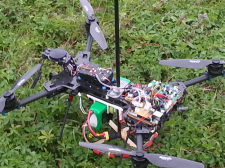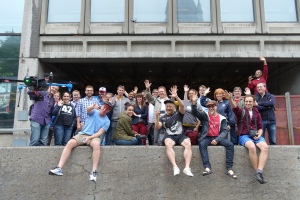 In my last post I discussed my little flying object detector project that I’ve been doing for fun. While it worked it relied on communication with an external laptop in order to work (the on board odroid was not powerful enough to run the convnet model).
In my last post I discussed my little flying object detector project that I’ve been doing for fun. While it worked it relied on communication with an external laptop in order to work (the on board odroid was not powerful enough to run the convnet model).
Hence, what better excuse to buy an NVIDIA Jetson TK1 dev board which should have more than enough juice to run everything on board the drone itself. As added benefit it should come in useful for my litter robot. I then added websocket support to the flask web app and you can now see the detections appear in real time on a map.
It took some fiddling to get the wifi to work with the Jetson and Im still surprised at how quickly the wifi degrades (even though Im using the 5GHz band to avoid collisions with the Tx/Rx). But it did work in the end:
It wasn’t the best place to test it out but I was short on time and it should be good enough to illustrate the concept
Still lots to do and too little time, but we keep chipping away. In particular the awesome folk from ErleBotics were kind enough to send me a Brain2, looking forward to try that out as well.
–Dirk
PS: on a related note, love what the guys from vertical.ai are working on

 About a year and a half ago I saw Jetpac’s video of their
About a year and a half ago I saw Jetpac’s video of their  The last in a series of 3 posts (
The last in a series of 3 posts ( Besides the machine learning angle discussed in the
Besides the machine learning angle discussed in the 

 Given my activity in the general Tech4Good space and
Given my activity in the general Tech4Good space and  Last week I attended the Autonomous Systems Showcase event at the University of Southampton. The focus of the event was to bring together industry, government and academia “to explore commercial and research opportunities to deliver the next generation of aerospace, marine, defence and other advanced systems technology to keep the UK at the forefront of these important industries“.
Last week I attended the Autonomous Systems Showcase event at the University of Southampton. The focus of the event was to bring together industry, government and academia “to explore commercial and research opportunities to deliver the next generation of aerospace, marine, defence and other advanced systems technology to keep the UK at the forefront of these important industries“. One liner summary: If you are interested in applying drone/UAV technology (or are already doing so) to humanitarian/social/conservation related problems, and you live in the UK.
One liner summary: If you are interested in applying drone/UAV technology (or are already doing so) to humanitarian/social/conservation related problems, and you live in the UK.  I have always been a fan of autonomous flying machines, particular their
I have always been a fan of autonomous flying machines, particular their  A bit late after the fact but I have been meaning to do a short post about the latest UAV test flight. A new airframe was developed as part of the European
A bit late after the fact but I have been meaning to do a short post about the latest UAV test flight. A new airframe was developed as part of the European